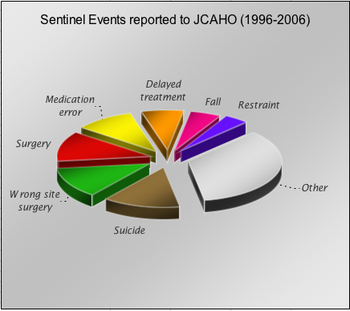
Sentinel event
Encyclopedia

Root cause analysis
Root cause analysis is a class of problem solving methods aimed at identifying the root causes of problems or events.Root Cause Analysis is any structured approach to identifying the factors that resulted in the nature, the magnitude, the location, and the timing of the harmful outcomes of one...
and to assist in development of preventative measures. The Joint Commission tracks events in a database to ensure events are adequately analyzed and undesirable trends or decreases in performance are caught early and mitigated.
Specific Events requiring review
Besides "unexpected occurrences involving death or serious physical or psychological injury, or the risk thereof", sentinel events also include the following, even if the outcome was not death or major permanent loss of function:- Infant abductionChild abductionChild abduction or Child theft is the unauthorized removal of a minor from the custody of the child's natural or legally appointed guardians....
, or discharge to the wrong family. - Unexpected death of a full term infant.
- Severe neonatal jaundiceNeonatal jaundiceNeonatal jaundice or Neonatal hyperbilirubinemia is a yellowing of the skin and other tissues of a newborn infant. A bilirubin level of more than 85 umol/l manifests clinical jaundice in neonates whereas in adults a level of 34 umol/l would look icteric...
(bilirubin over 30 milligrams/deciliter). - Surgery on the wrong individual or wrong body part.
- Surgical instrument or object left in a patient after surgery or another procedure.
- RapeRapeRape is a type of sexual assault usually involving sexual intercourse, which is initiated by one or more persons against another person without that person's consent. The act may be carried out by physical force, coercion, abuse of authority or with a person who is incapable of valid consent. The...
in a continuous care setting. - SuicideSuicideSuicide is the act of intentionally causing one's own death. Suicide is often committed out of despair or attributed to some underlying mental disorder, such as depression, bipolar disorder, schizophrenia, alcoholism, or drug abuse...
in a continuous care setting, or within 72 hours of discharge. - Hemolytic transfusionBlood transfusionBlood transfusion is the process of receiving blood products into one's circulation intravenously. Transfusions are used in a variety of medical conditions to replace lost components of the blood...
reaction due to blood group incompatibilities. - Radiation therapyRadiation therapyRadiation therapy , radiation oncology, or radiotherapy , sometimes abbreviated to XRT or DXT, is the medical use of ionizing radiation, generally as part of cancer treatment to control malignant cells.Radiation therapy is commonly applied to the cancerous tumor because of its ability to control...
to the wrong body region or 25% above the planned dose.
In additional to the list above, The Joint Commission requires each accredited organization to define sentinel events for its own care system and put into place monitoring procedures to detect these events and a procedure for root cause analysis.
Actions and reporting
Participation is necessary by the leadership of TJC accredited healthcare organizations and by the persons closely involved in the systems under review. Causal factors are analyzed, focusing on systems and processes, not individual performance. Potential improvements, called an "action plan", are identified and implemented to decrease the likelihood of such events in the future. Each accredited organization is encouraged, but not required, to report any sentinel event to The Joint Commission. However, the organization is expected to prepare a root cause analysis and action plan within 45 calendar days of the event. In addition, healthcare organizations are required to notify the Food and Drug AdministrationFood and Drug Administration
The Food and Drug Administration is an agency of the United States Department of Health and Human Services, one of the United States federal executive departments...
(FDA) and device manufacturers within 10 days of a sentinel event caused by a medical device, according to the Safe Medical Device Act of 1990. Statistics of sentinel events are recorded and published by the FDA's MedWatch
MedWatch
MedWatch is the Food and Drug Administration’s reporting system for an adverse event or sentinel event, founded in 1993. An adverse event is any undesirable experience associated with the use of a medical product...
program.
Advantages of reporting sentinel events to The Joint Commission are:
- Adding to the database with dissemination to other health care facilities, preventing other adverse events.
- Consultation with The Joint Commission on implementing the root cause analysis and action plan.
- Association with national accrediting body reassures the public that all steps are being taken to prevent a recurrence.

